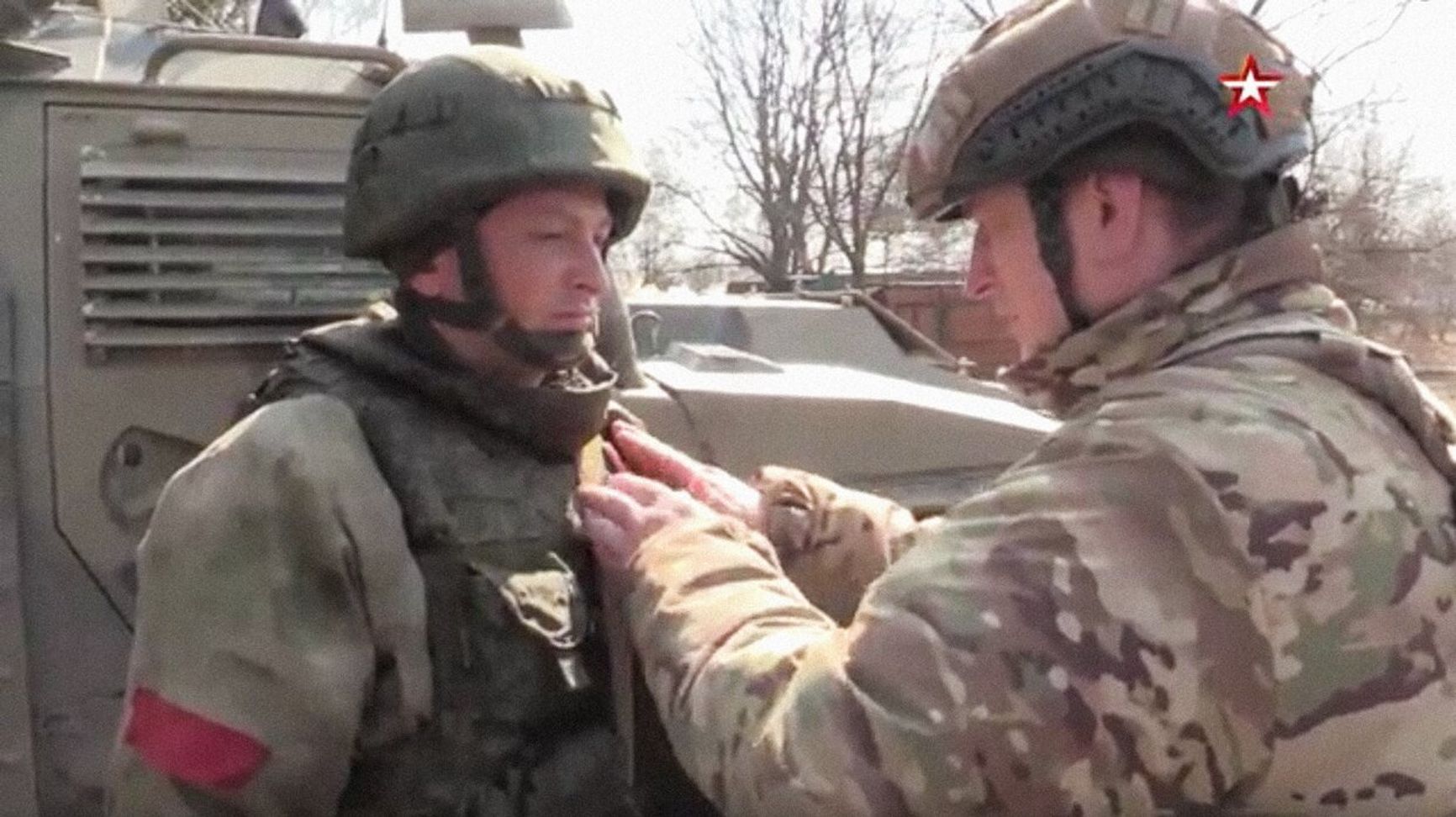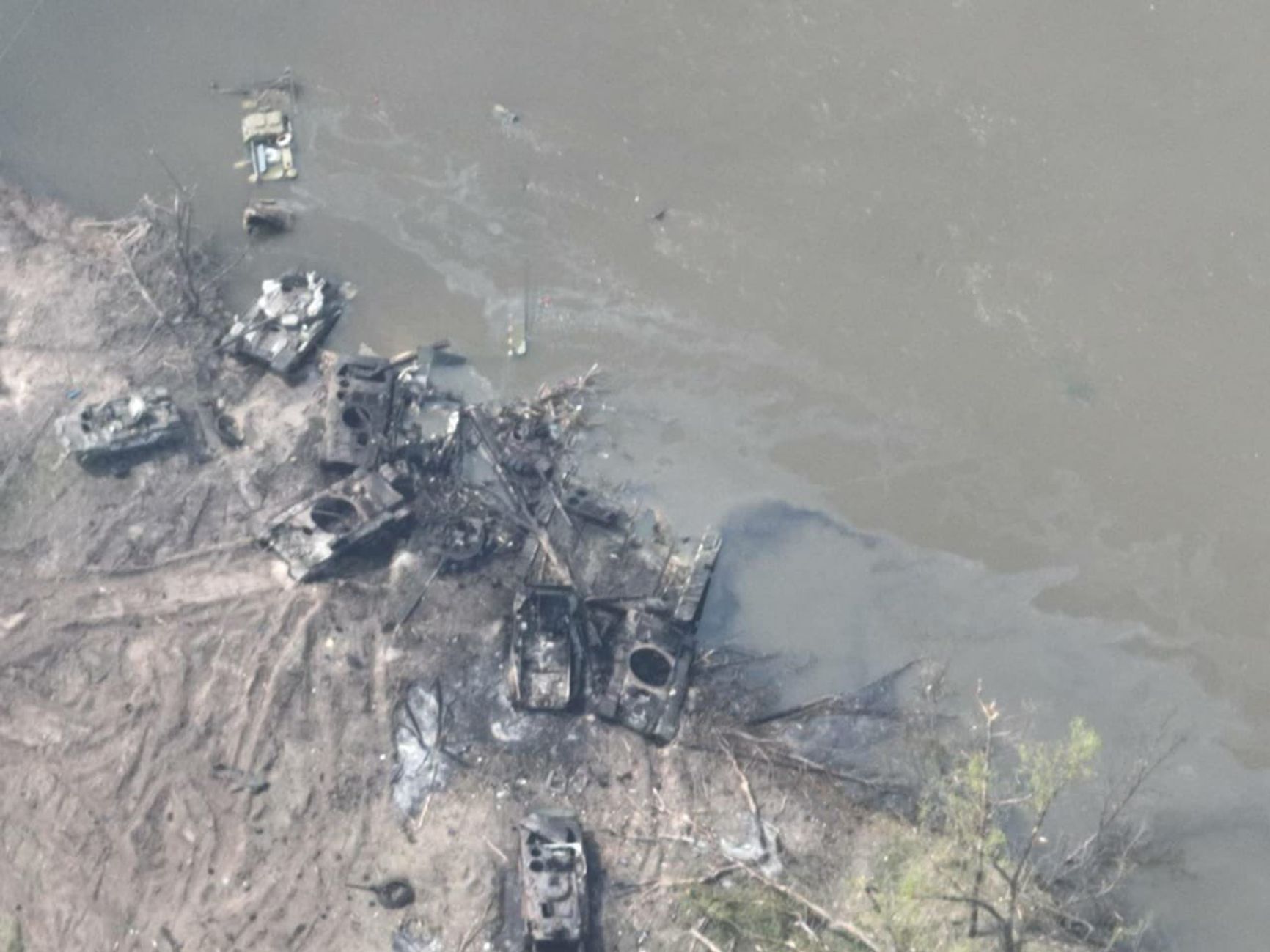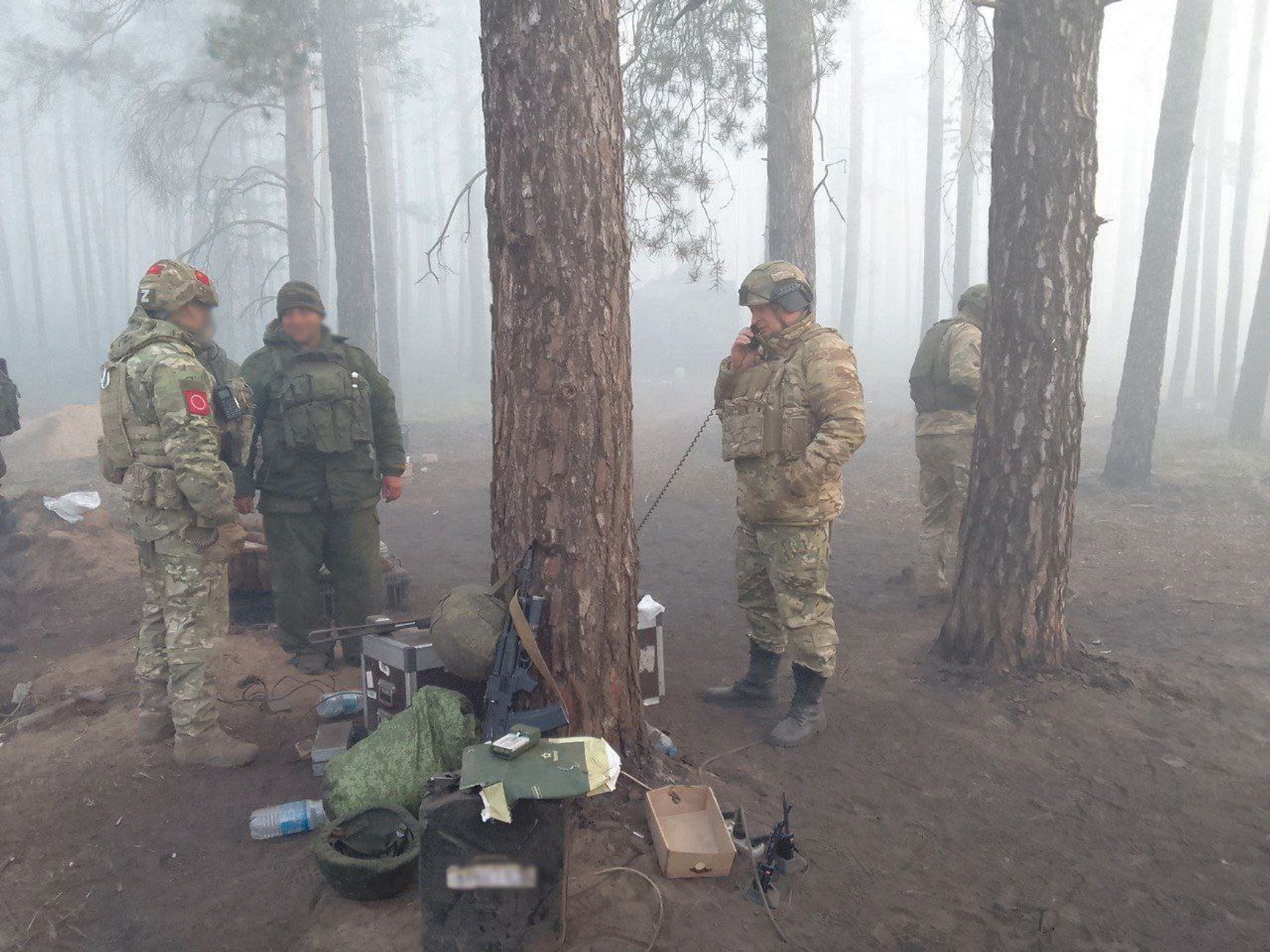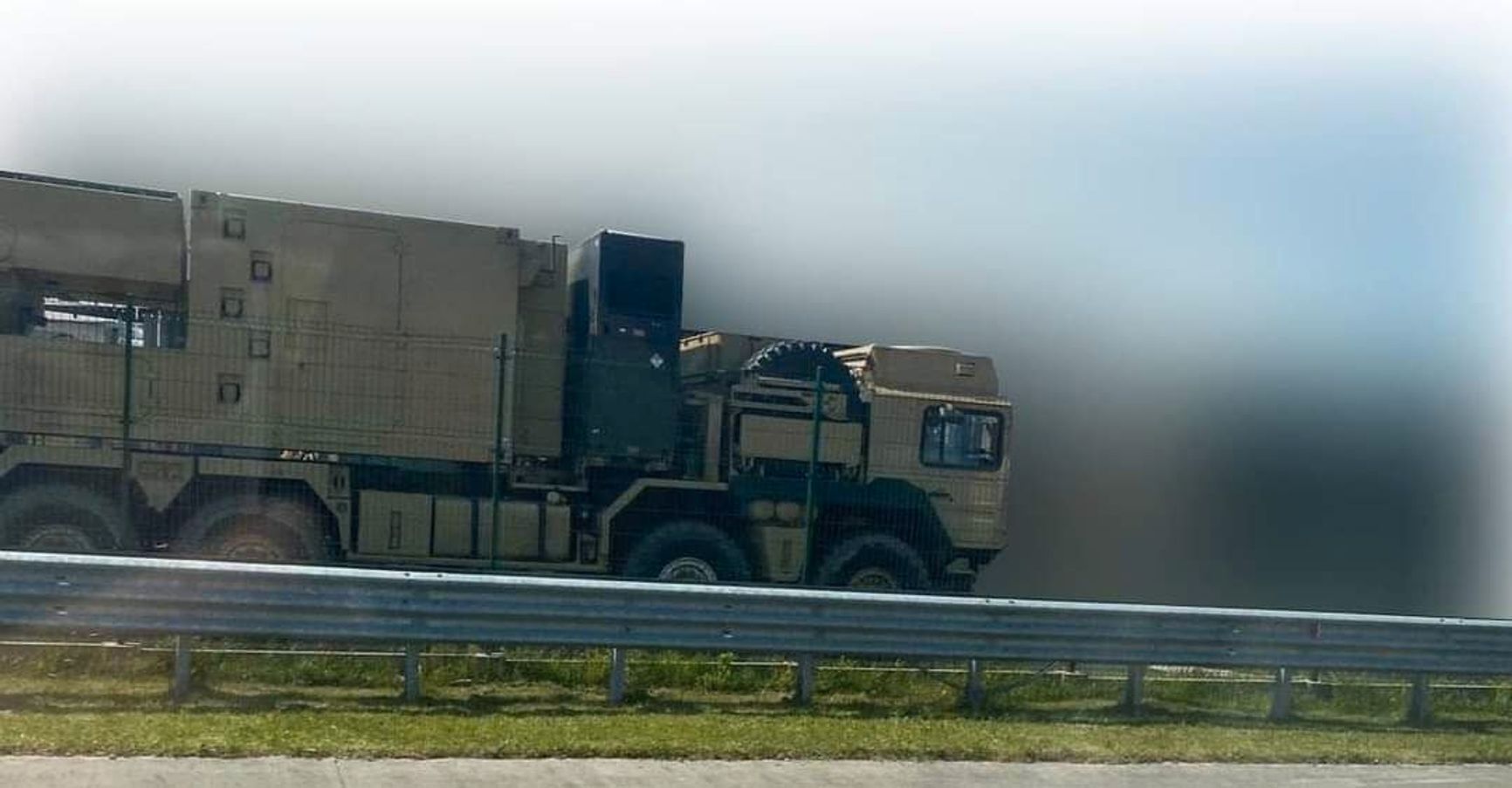
In today's summary:
- The Russian Interior Ministry is beginning its work in Bakhmut, with finding civilians in the city outlined as its first task;
- General Lapin is back – in two clearly staged videos filmed during the recent Belgorod incursion;
- Military expert Leonid Dmitriev estimates the number of Russian troops along the border with Ukraine at 17,000;
- Independent researchers suspect that some of the photographs of the destroyed equipment in Belgorod are staged;
- Wagner Private Military Company founder Yevgeny Prigozhin estimated that the group lost 20,000 men killed during the capture of Bakhmut;
- The US military has begun training Ukrainians on M1A1 Abrams tanks;
- Germany transfers over a new batch of military aid to AFU: reconnaissance UAVs, trucks, and engineering vehicles;
- Ukraine has confirmed the use of Storm Shadow missiles, with their likely carrier being an Su-24M tactical bomber.
The front line
For the first time since December 2022, the Armed Forces of Ukraine (AFU) General Staff did not mention the fighting in Bakhmut in its official report, according to an observation by analysts at the US-based Institute for the Study of War (ISW). In their opinion, this might indicate that the Wagner Group is moving deeper into the city. Despite the town not being mentioned, the AFU General Staff did report about unsuccessful Russian offensive actions near the village of Khromove, west of Bakhmut.
The day before, Ukraine’s Deputy Defense Minister Anna Malyar said that the AFU still occupied fortified positions in the city near a famous monument with the MiG-17 aircraft. A spokesman for the AFU’s eastern command, Serhiy Cherevatyi, issued a similar statement.
According to Denis Pushilin, head of the so-called “DPR,” the Russian Interior Ministry is beginning its work in Bakhmut – the first task of the agency will be to determine the presence or absence of civilians in the city. Pushilin claimed that the “peak of anxiety” on the flanks around Bakhmut (i.e. the threat of encircling strikes by the AFU) has passed, and “the situation is stabilizing.”
One of the founders and the main public representative of the Wagner PMC, Yevgeny Prigozhin, said in an interview that the mercenaries intend to transfer their positions in Bakhmut to the Russian Armed Forces from June 1 to 10.
The Telegram channel Rybar, affiliated with the Russian Ministry of Defense, was the first to report that the Russian reconnaissance ship Ivan Khurs was attacked by marine drones in the southern Black Sea. Subsequently, the Defense Ministry published footage of the apparent destruction of one of the kamikaze drones.
The ministry's report claimed a total of three uncrewed boats attacked the ship about 140 kilometers northeast of the Bosphorus Strait.
Shelling and sabotage
Russia is taking stock of the raid of a sabotage and reconnaissance group, allegedly composed of fighters from two units fighting on the Ukrainian side and made up of Russian citizens, the Russian Volunteer Corps (“Russky Dobrovolchesky Korprus”, or RDK) and the Freedom of Russia Legion (“Legion Svoboda Rossii”, or LSR), in the Belgorod region.
The head of the region, Vyacheslav Gladkov, reported “a large number of attacks” carried out by drones. He also wrote about damage to a gas pipeline in the Grayvoron district, which resulted in a “small fire,” as well as close to nine victims of the attack, three of whom are currently in intensive care.
The most prominent videos related to the repulsion of the “sabotage group” attack in Belgorod Oblast feature General Alexander Lapin – one of most highly-mentioned characters in the current war against Ukraine.
At the beginning of the war, Lapin became famous for awarding his son Denis, a Russian army officer taking part in combat in the Ukraine’s Chernihiv region, a medal (according to the Ukraine’s Security Service, Lapin’s son was awarded the Order of Courage). Lieutenant Colonel Denis Lapin, commander of the 1st Tank Regiment of the 2nd Tamanskaya Motorized Rifle Division of Russia’s 1st Tank Army, managed to lose half of his T-72B3M tanks in three weeks of combat. The award took place when the Russian army had already withdrawn from Kyiv, Sumy and Chernihiv after an unsuccessful offensive.

In mid-May 2022, Lapin, who commanded troops from Russia’s Central Military District (CMD), ordered a pontoon crossing over the Siversky Donets River near the village of Belohorivka in the Luhansk region. Ukrainian artillery attacked the crossing several times, which resulted in the Russian side, losing about a hundred vehicles and almost half a thousand soldiers, according to some estimates.

In October, Chechen leader Ramzan Kadyrov accused Lapin of allowing the Ukrainians to breach Russian defenses near Terny, Torske and Yampolivka. Kadyrov also said that the general was absent from combat positions, and failed to maintain communication. According to the head of Chechnya, Lapin received an award for the capture of Lysychansk, but had never been to this city.
A later report claimed that the general attempted to prevent the retreat of the Russian troops from Svatove by putting a gun to one serviceman’s head and threatening to shoot another.
However, all this did not prevent him from serving as commander of the Central Military District until early November 2022. At that time, the Defense Ministry announced the appointment of a new commander of the Central Military District “for the period of [Lapin’s] absence”. Officially, Lapin was fired only in February 2023. However, he received a new position as Chief of the Main Staff of Russia’s Ground Forces in January 2023.
In a recent video filmed during the RDK and LSR’s incursion in the Belgorod region’s Grayvoron district, Colonel General Alexander Lapin, deputy commander of the United Group of Forces in Ukraine, can be seen leading about a dozen soldiers into an attack and shouting: “Move the f*ck forward! For the Motherland!”
In another video, Lapin takes on the role of a traffic controller, directing a BMP-1 infantry fighting vehicle passing along a perfectly straight paved highway, shouting: “Let's go!”
Lapin’s location in these videos was not difficult to establish. Both videos were filmed in the village of Glotovo, where there were no military operations at that time. When the videos were filmed, combat was underway at the “Grayvoron” checkpoint on the Russian-Ukrainian border. This means that Lapin was nowhere near the fighting, as he was about 5 kilometers (3 miles) away from the checkpoint.

Lapin's adventures in the Belgorod region resemble a campaign in the military commander's defense, which was launched in response to criticism from Kadyrov. For example, “military correspondent” Alexander Kharchenko wrote how Lapin led a special forces unit to catch “sabotage groups” near the Oskol river. Footage of the colonel-general teaching a mobilized man to fire a machine gun was also circulated online.
“Some people don't quite understand why General Lapin is back at the front, commanding again,” propagandist Andrei Medvedev wrote in his Telegram channel in April. He immediately found an explanation – allegedly, in September 2022, only through Lapin's efforts did the front hold, as the general had “come to the front line.” He personally “commanded, walked in the trenches, and sat in the dugouts.” In support of this, Medvedev cited video and photos, one of which shows Lapin speaking on a field telephone while standing somewhere in the woods.

Longtime enemies – one of the field commanders of the pro-Russian separatists in Donbas in 2014, Igor Girkin (also known by the last names Strelkov and Runov), and another former separatist commander, Igor Bezler – have presented a rare united front to criticize the general.
Bezler called Lapin a “rookie” who “managed to blow his personal weapons, his armor, his communications” and “is trying to command by voice next to a working BMP [infantry fighting vehicle] engine.” Girkin “retracted” his previous statement on General Lapin being a “moron,” and acknowledged his abilities as a “traffic controller,” which a “complete moron” would not be able to do.
Shelling continued in Russia’s Belgorod region. Governor Vyacheslav Gladkov reported that the Belgorodsky district was shelled eight times, Borisovsky district was shelled twice, Volokonovsky district came under mortar fire, Grayvoronsky district was shelled nine times, and the Shebekinsky district was shelled 13 times.
In an exclusive comment for The Insider, military analyst Leonid Dmitriev for The Insider gave an estimate of the number of forces and means of the Russian Armed Forces concentrated along the “old” Russian-Ukrainian border (in the Belgorod, Kursk and Bryansk regions). According to Dmitriev, there are only 25 battalion tactical groups (BTGs) with a serious shortage of standard equipment:
In the Kursk, Bryansk and Belgorod regions, along the border with Ukraine, there are up to 25 theoretical battalion tactical groups totaling close to 17 thousand people. These BTGs are stretched along the border and are not concentrated in a single location – a sector.
The total number of combat-ready vehicles in these tactical groups makes them quite arbitrary, as they are not nearly equal to standard strength. In particular, these units are armed with:
Tanks – about 100 instead of the regular 275;
Armored fighting vehicles – slightly more than 360 instead of the regular 825;
Tube artillery – 200 instead of regular 300;
Multiple rocket launchers – 30 instead of the regular 300.
Dmitriev drew attention to the fact that with the length of the «old» border of 700 km the present 25 BTGs will be enough to reliably cover only 125 km, but only if they are properly staffed with personnel, armament and equipment:
The Kursk, Bryansk, Belgorod regions – this is over 700 km of the border with Ukraine, and 25 BTGs are physically unable to cover this front. The standard BTG norm when on the defensive is 4-7 km, but taking into account the current situation it is 1 BTGr per 1-2 km of the front.
According to regulations, 25 BTGs can cover up to 125 km of the front when defending, provided that they are fully staffed, both in terms of personnel and weapons and military equipment.
Strikes on Ukrainian territory by Shahed-type (aka Geran) kamikaze drones continued, as six UAVs attacked Velykyi Burluk in the Kharkiv region.
Losses
There is fierce debate about the losses of the Ukrainian-backed units during the raid in the Belgorod region.
A Twitter user with the nickname Jack's House, whose tweet was retweeted by Bellingcat founder Eliot Higgins, wrote that the photos, which show two M1151 HMMWV infantry mobility vehicles allegedly abandoned in a trench, show signs of being staged. He believes that the vehicles were not stuck, but were pushed into the trench, as evidenced by a rut under the right tire of the first vehicle. The second one, judging by the image, should have hit the wall of the ditch, but that would have caused ground to be thrown out of it, which is absent from the image. The analyst believes that both vehicles were brought to the location by a crane to make the picture look more dramatic.
Russian pro-war bloggers have also published photos that show the alleged capture of two US-made International MaxxPro armored personnel carriers, an M1152 army infantry vehicle, and an AMZ Dzik-2 armored vehicle. There is also evidence of a KRAZ Cobra armored vehicle and an Isuzu TF pickup truck being destroyed.
Even pro-war commentators suspected that some of the Ukrainian equipment presented by the Russian side as destroyed was in fact not lost in combat. Many analysts, such as the Conflict Intelligence Team, suggested that some vehicles may have been abandoned by saboteurs elsewhere, after which the Russians brought them to the checkpoint for a “pretty picture.”
The New York Times reported that the units involved in the Belgorod raid suffered minor losses, which were “not enough to affect their combat readiness.” A senior Ukrainian official told the NYT that AFU servicemen provided support to the formations that entered Russian territory, and covered the border in case of a Russian counterattack. No Ukrainian servicemen allegedly crossed the Ukrainian-Russian border, according to the official.
Russia’s MoD remains silent on the matter of Russian losses.
The publication 7x7 reported that at least seven conscripts have been killed on the border in the Belgorod region since the start of the war. The publication said that the conscripts are formally stationed out of the combat zone as they should be by law, but in reality they come under fire and are wounded when carrying out their duties as border guards. The soldiers themselves say that they receive practically no training in shooting and handling weapons.
The mother of an 18-year-old conscript soldier who was wounded during the Belgorod incursion also confirmed that information to the Russian Telegram channel VChK-OGPU. According to the woman, after Russia’s military draft, the recruits were scattered across different points to guard the country’s border. The woman claimed that 25 servicemen guarded the Grayvoron area at the time of the attack, of whom one was a lieutenant, one was mobilized, and the rest were conscripts.
Meanwhile, Yevgeny Prigozhin spoke of the losses of the Wagner PMC in the operation to capture Bakhmut in a video interview. According to Prigozhin, there were 35,000 fighters in the ranks of the PMC at the start of the siege of the city. During the entire span of the so-called “special military operation,” 50,000 people were recruited from Russia’s prisons. 20% of them (10,000 prisoners) were killed in battle. Another 10,000 “regular” PMC fighters were also killed. This indicates that the Wagner Group’s total losses killed in action amount to 20,000 people.
Prigozhin also claimed that the AFU lost 50,000 dead only in Bakhmut (three times more than the US estimate of Ukraine’s total losses killed during the full-scale war, as of late February 2023, as stated in the leaked Pentagon documents). This assertion could shed doubt on Prigozhin's estimates.
Earlier, US National Security Council spokesman John Kirby had cited a total figure of 100,000 Russians killed and wounded since the beginning of the year, half of which were lost in Bakhmut, according to the official. According to a Ukrainian estimate, which was announced by Defense Minister Oleksii Reznikov on May 19, Russia had lost a total of 70,000 soldiers killed and wounded in Bakhmut.
Igor Girkin (Strelkov) wrote that according to his information, the losses of the Wagner PMC are “at least” one and a half times larger than described by Prigozhin. Girkin concluded that Wagner losses during the storming of Bakhmut amounted to 40,000 people “at the very minimum.” At the same time, he estimated the total losses of all Russian formations in the battles for Soledar and Bakhmut at 50,000.
Fighterbomber, a Telegram channel associated with the Russian Air and Space Force, wrote that on May 13, two helicopters and two planes were shot down in the sky over the Bryansk region using American Patriot SAM (surface-to-air missile) systems from the territory of Ukraine. CNN sources previously claimed that Ukraine shot down a Russian aircraft with a Patriot – at the time, many analysts speculated that this referred to the strike that took place over the Bryansk region..
Recently, there was another aerial battle in the skies over Ukraine: the Telegram channel Escadrone published a video of a Ukrainian FPV drone ramming an enemy DJI Mavic reconnaissance drone (which costs several times more). Mikhaylo Fedorov, Ukraine’s Minister of Digital Transformation clarified that the Ukrainian side used the Pegasus kamikaze drone in the attack, delivered within the “Army of Drones” project on donations collected through the UNITED24 presidential foundation and the Ukrainian “Dia” government services app.
Arms supplies
Russian pro-war channel Military Informant (“Voyenniy Osvedomitel”) published a video of a strike carried out using FAB-500M62 air bombs equipped with UMPK modules [universal planning and correction modules, which turn free-falling munitions into guided bombs – The Insider]. The channel’s authors said that both munitions failed to reach the target, indicating some problems with the module, although they insisted those were not systemic.
The US military will begin training Ukrainians to operate M1A1 Abrams tanks “in the coming days,” according to a statement from Pentagon spokesman Pat Ryder. 250 Ukrainian military personnel will arrive in Germany, and training will take place on 31 Abrams tanks. Another 31 Abrams M1A1 tanks are currently under repair and will arrive in Ukraine in the autumn. The training course is expected to take 10 weeks.
British Defence Secretary Ben Wallace arrived in Kyiv on an official visit. Wallace and his Ukrainian counterpart, Oleksii Reznikov, discussed the possibility of Ukraine's admission to NATO, the upcoming NATO summit in Vilnius, as well as what weapons the Ukrainian side needs as matter or priority. Wallace confirmed the transfer of Storm Shadow air-launched cruise missiles, which have a range of over 250 km, to Kyiv.
On his part, Reznikov tweeted a photo of a Ukrainian Su-24 tactical bomber carrying the missiles. The Ukraine Weapons Tracker project published a high-resolution version of the image and specified that it showed an Su-24MR reconnaissance aircraft from AFU Air Force’s 7th Tactical Aviation Brigade Until recently, the researchers note, the plane was of little use, as spy planes operate at an altitude where they are extremely vulnerable to modern means of air defense – but it has now gained a “second life” as a cruise missile platform.

Ukraine’s Ambassador to Germany, Oleksii Makeiev, announced that the AFU would soon receive 110 Leopard 1A5 tanks. He also announced that the Netherlands had allocated €260 million ($278 million) for the purchase of 155-mm artillery ammunition for Ukraine. Earlier, EU head diplomat Josep Borrell, reported that the EU had already delivered 220,000 shells to Ukraine since March – out of the one million promised for the year.
German COBRA counter-battery radars, which were handed over to Kyiv by the Bundeswehr in September, have been spotted in Ukraine for the first time.

Germany has also updated the list of military equipment transferred to Ukraine. The new deliveries include:
- 1 TRML-4D air surveillance radar;
- 2 BEAVER armored bridgelayers
- 3 mobile and protected mine clearing systems
- 54 VECTOR reconnaissance drones
- 8 frequency range extensions for anti-drone devices
- 6 border protection vehicles
- 1 communications electronic scanner/jammer systems
- 2 load-handling trucks 8x6 with 20 roll of containers
- 5 8x8 HX81 truck tractor trains and 12 semi-trailers
- 8 vehicles (trucks, minibuses, all-terrain vehicles)
- 34 pick-up trucks
- 8 Zetros trucks
Click here for The Insider's summary of the main events on the front line on May 23.